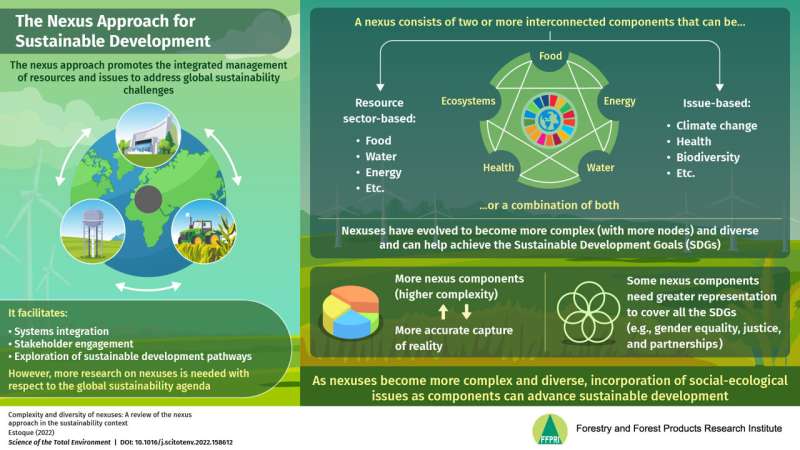Using the nexus approach to identify systematic solutions for sustainable development

The United Nations Sustainable Development Goals, adopted in 2015, tackle a wide array of contemporary issues such as food, water, and energy insecurity, biodiversity loss, climate change, and rapid and spontaneous urbanization. Achieving these goals requires a strategy aimed towards overall progress, rather than improvement in isolated areas.
The nexus approach is a method for dealing with sustainable development challenges in an integrated manner considering multiple variables at once. The word "nexus" is conventionally understood to mean "link" or "connection," and the aptly named approach involves the assessment of several interconnected components. Components can be based on resource sectors, issues, or a combination of both.
The interactions between these components can be studied in a structured manner, where progress on one front might require a compromise on another (trade-off), or where two components mutually benefit from one another (synergy). Originally emerging in the early 1980s, the nexus approach has since evolved to become more complex (more components) and diverse (more distinct nexuses) and has recently garnered interest for its integrated approach to tacking global sustainability challenges.
In a recent review of the complexity and diversity of nexuses published in Science of the Total Environment, Dr. Ronald C. Estoque, a Senior Researcher from the Forestry and Forest Products Research Institute, Japan, explains how the trends of development in the nexus approach can help achieve the Sustainable Development Goals. The article was made available online on September 8, 2022 and will be published in Volume 854 of the journal on January 1, 2023.
"Examining how the complexity and diversity of nexuses have progressed over the years, especially in recent years, might provide some insights into the future direction of the nexus approach and whether such a direction is consistent with or geared towards helping to achieve global sustainability," says Dr. Estoque.
Through a systematic review of over 300 publications, Dr. Estoque found that nexuses have become more complex and diverse over time. This implies that a particular nexus now deals with many more components than included earlier. In the context of sustainability, this is advantageous, as it allows for a more fine-tuned analysis of real-world situations. Increased diversity also means that the components in different nexuses now cover a wider variety of resource sectors and issues.
While the nexus approach was introduced in the early 1980s, tracing its history revealed that it was popularized in the sustainable development context much later, in recent years. The trends in the development of this approach since then have only made it more suitable for application towards meeting the Sustainable Development Goals. It is expected that, with time, several different issues and resource sectors will be linked as components to the existing nexuses, allowing better planning and management.
Currently, the nexus approach offers a platform for systems integration, with careful consideration of the interactions between different components; a platform for collaboration between scientists, policy makers, and other stakeholders; and an explorative method for prospective evaluation of potential future impacts of an intervention.
Although the nexus approach is promising, exactly which components should be included while planning for sustainable development policies remains a big question. In Dr. Estoque's own words, "Determination of the key nexus components for, and in the context of, the global sustainability agenda is an important task, although it is certainly not an easy nor a straightforward one."
More information: Ronald C. Estoque, Complexity and diversity of nexuses: A review of the nexus approach in the sustainability context, Science of The Total Environment (2022). DOI: 10.1016/j.scitotenv.2022.158612
Journal information: Science of the Total Environment
Provided by Forestry and Forest Products Research Institute




















